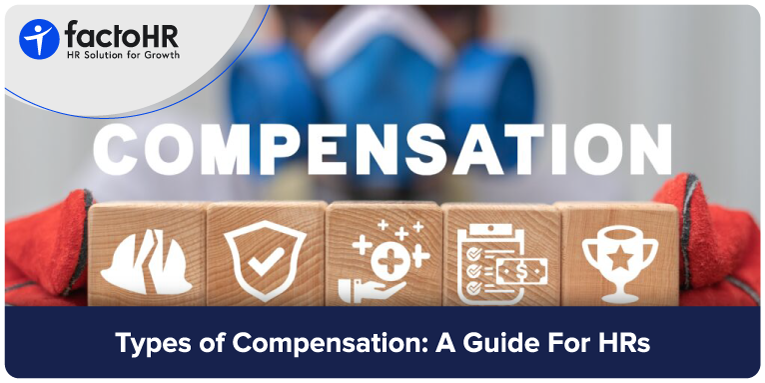Types of Compensation: A Complete Guide for HR Professionals

Table of Contents
When speaking of human resources that are constantly developing and changing, compensation has a critical role in building talent. In this context, compensation is not only limited to a monetary reward system; it is defined as those things given to the employee by the employer in return for work.
When organizations battle to attract employees, it becomes equally essential for human resource practitioners and organizational managers to introduce compensation packages that appeal to the employees.
In this blog, we aim to uncover the basics of compensation, why it is crucial, why various types of compensation exist, and what they hold for employers and employees.
What is Compensation?
Compensation refers to workers’ total rewards for their services in an organization. This includes monetary payments, like wages or salaries, and other cash incentives, such as bonuses, commissions, and overtime pay, tied to performance and business goals.
It also covers fringe benefits, which are extras like health insurance, retirement plans, paid leave, and educational support. These benefits can boost job satisfaction and improve overall employee health. A good compensation strategy can help attract employees and reduce turnover, resulting in better organizational performance and success.

Types of Compensation in HRM
It Is Typically Categorized Into Two Primary Types of Compensation
- Direct Compensation
- Indirect Compensation
1. Monetary/Direct Compensation
Direct compensation is the money employees earn for the work they do. It usually refers to salary or wages, making it simple to define and calculate. This type of compensation rewards employees for helping the organization reach its goals. It is important for attracting candidates to a job and influencing their decision to accept an offer. Additionally, it is a major motivator for performance.
Basic Wages/salaries
Familiar with full-time and skilled employees, a salary is a predetermined number of dollars paid monthly or yearly. This structure typically shows the employer’s resource commitment to the employee in the long run. Teachers, doctors, and managers are among some of those who are usually paid a salary.
Allowances
Allowances are extra benefits that help employees cover daily needs beyond their base salaries. Common types include:
- House Rent Allowance: Supports housing costs, varying by metro and non-metro areas.
- Dearness Allowance: Helps employees cope with rising prices.
- Leave Travel Allowance: Provides funds for vacations.
- City Compensation Allowance: Helps with higher living costs in certain cities.
- Special Allowance: Offers extra support and motivation, including overtime and travel allowances.
Commission
The commission is primarily employed in sales-oriented functions. It rewards employees in proportion to the sales they achieve in goods or services. The more units sold, the more returns and, thus, more revenue, encouraging higher production rates.
Bonuses and Incentives
Bonuses include any monetary award given to the employee to recognize achievements within the company or enhance company performance. Such bonuses may be used yearly, every three months, or based on a project and are awarded for exceptional performance over and above the set target.
Benefits
In some occupations, employees may be paid a wage with many tips. Tips can form a significant percentage of their earnings, primarily when they work in restaurants as waiters and bartenders.
Merit-based Pay
This system utilizes merit-based approaches to motivate employees. This can entail issuing promotions or even pay increments based on the employee’s achievements or if they have achieved specific goals that were set.
Piecework/Project Work
Usually, it is flexible work where one is paid depending on the number of hours or projects delivered rather than an hourly wage.
2. Non-monetary/Indirect Compensation
An indirect approach to compensation refers to the system of non-salary motivating factors offered by an employer to an employee. Unlike salaries, these remain indisputable employee satisfaction, devotion, and longevity incentives. When effective indirect compensation measures are aligned, they will improve organizational culture regarding employee engagement and productivity.
Employees perceive these as extra perks that form part of their total compensation package, which is rare in most companies. Second, direct and indirect compensation can be seen as significant employee rewards recognizing monetary and nonmonetary investments.
Equity Packages
In addition to offering incentives, it is recommended that workers be allowed to patronize the company. Therefore, employees will be more committed to the firm and its development than contract workers.
Stock Options
These allow the employees to buy the company shares at a particular price at some point, which can be a successive financial return if the company’s worth is high.
Benefits
These rewards are an essential part of remuneration. Such benefits include medical insurance, pension, insurance, merchandise discounts, and other services that are essentially the health of their employees.
Non-financial Compensation
Even if these do not relate to salary, they are incentives that improve an employee’s lifestyle and are
- Paid Time Off (PTO): Employees need time off, like vacation and sick days, to rest.
- Learning and Development: Training programs help employees grow and benefit the organization.
- Flexible Work Schedules: Companies can allow different start and end times, including work-from-home options.
- Childcare Benefits: Childcare support is vital for working parents and helps retain talent.
While developing a compensation package, employers should remember that employees’ needs and priorities are different, as are their views on the most valuable benefit. When these compensation types are well calibrated, they will create a package appealing to all employees.

Why is Compensation Important?
Recognizing different types of employee compensation is key to attracting and managing talent in a competitive job market. Employee Compensation can be direct, like salaries, or indirect, like benefits, and should align with employees’ needs to boost satisfaction and loyalty.
A strong compensation strategy connects employee performance to organizational goals, creating a collaborative workplace. A well-designed compensation program is vital for several reasons:
1. Attraction of Talent
In a competitive market, the right compensation mix must attract suitable candidates to the company. A recruiting package is one practical selling point that could attract potential employees and set the organization ahead of competitors within the industry domain.
2. Employee Retention
The main idea for addressing attrition is to provide a complete compensation package to employees. Workers who believe they are being paid the correct wage will likely remain committed to the organization, decreasing employee turnover costs.
3. Employee Motivation and Productivity
Staff motivation plays a vital role in achieving goals. Offering motivation and rewards tied to employee performance will help motivate workers to perform even better and thus improve organizational performance.
4. Engagement and Satisfaction
Job satisfaction and involvement are well-anticipated when the compensation structure mixes monetary and other benefits. Employees who feel valued will enhance the organization’s culture and mission, reducing absenteeism and improving morale.
5. Alignment with Business Goals
Compensation policies should always fit the company’s long-term goals. This allows the incentives employed in the facility to motivate behaviors and achievements central to the organization’s success to be shared between the employees and the business entity.
Consequently, competencies in the types of compensation are essential in any organization that aims to achieve growth and sustenance.

Benefits of Different Types of Compensation
Benefits of Direct Compensation
The biggest strength of direct compensation is that it almost immediately affects employees’ attitudes, motivation, and performance. Employees who are paid well and given other incentives for high performance develop positive morale, which results in increased productivity.
Moreover, monetary compensation offers organizations a chance to hire the best employees in the overcrowded world and have the right skills that will lead them to organizational success. It also increases budget transparency and regulation because businesses can directly assign payroll costs and easily regulate their budget.
Benefits of Indirect Compensation
The main advantage of indirect compensation is improving employee loyalty and retention. Companies that provide full benefits show their employees that they care about their well-being for many years to come and increase their employees’ productivity, which means organizational loyalty will increase.
Furthermore, non-monetary may help organizations meet employees’ various wants and needs, making achieving a representative work environment easier. When employees’ multiple needs are being met and they are healthy, they will likely be productive, enhancing organizational performance.
Knowledge of the various perks that various types of compensation entail for both parties, employers and employees, allows the creation of effective compensation policies.
Benefits for Employees
Financial Security
This pay strategy covers the cash benefits that the employees require for basic living in the future to ensure order and stability.
Career Growth
This rewarding method helps encourage employees to deliver their best and receive clean confirmation of the promotions and skills they have acquired.
Work-life Balance
Guaranteed rewards like paid vacations and other flexible hours increase work-life balance, thus improving workplace satisfaction and lowering burnout.
Health and Wellbeing
Perks like insurance and fitness activities show the employer’s interest in employees and consequently receive appreciation and boost effectiveness.
Ownership Sense
Equity options and stock incentives make employees feel part of the company, giving them a stake in performance and creating loyalty.
Benefits for Employers
Attraction and Retention
Broader pay structures promote good staff by appealing to ‘hire’ and ‘fire,’ which is crucial to strategic management plans.
Enhanced Employee Engagement
Companies that implement flexible working systems and eligibility to select among diverse remuneration packages have higher overall rates of workforce motivation and appreciation.
Performance Alignment
Pay-for-performance systems are straightforward compensation systems that can motivate efficiency and profitability within organizations.
Cost Management
Compensation management Labour cost remains a sensitive factor in any organization, and it can be costly, mainly when recruiting highly skilled staff or offering incentives to those recruited. The following strategy shows how employers can manage costs appropriately while offering drivers appropriate packages based on their needs.
Employer Brand Strengthening
The added perception of the organization as fostering and providing for employees also strengthens the employer brand, thus further increasing its appeal to prospects.
Overall, the proper combination of compensation types promotes the successful functioning of an organization’s employees and positively impacts its results and development.
Conclusion
In conclusion, organizations need adequate knowledge of direct and indirect compensation types to attract and retain more talent. Direct compensation, which includes salary, bonuses, and incentive programs, is essential for employees’ financial gains. In contrast, indirect compensation, which includes factors like health insurance, retirement, and paid vacation, promotes good health and well-being for the employees.
All the types of compensation elements are crucial for developing a sophisticated and attractive pay structure to achieve business initiatives and employee satisfaction. Therefore, Compensation strategies should be clear and consistent to show the reasonableness of the provided pay structure’s importance to the workforce and overall organizational objectives.

Frequently Asked Questions
What is the Definition of Compensation?
Compensation is the money someone earns for their work. It includes salary or wages, commissions, and job benefits.
What is Compensation in HRM?
Compensation is what an employer pays an employee for their work. It includes money and benefits like salary, wages, bonuses, paid leave, and stock options.
What are some Examples of Typical Benefits Provided under the Compensation Structure?
Some organizational benefits include medical insurance, pensions, paid vacation, flexible working hours, and training.
What are the Best Ways to Maintain My Compensation Strategy’s Competitiveness?
Check from time to time how the more established businesses around you pay their employees, conduct surveys, and brainstorm. The primary recommendation is to remain flexible and prepared to change a company’s HR practices in response to changes in the needs of its employees and general market trends.
Grow your business with factoHR today
Focus on the significant decision-making tasks, transfer all your common repetitive HR tasks to factoHR and see the things falling into their place.

© 2026 Copyright factoHR


